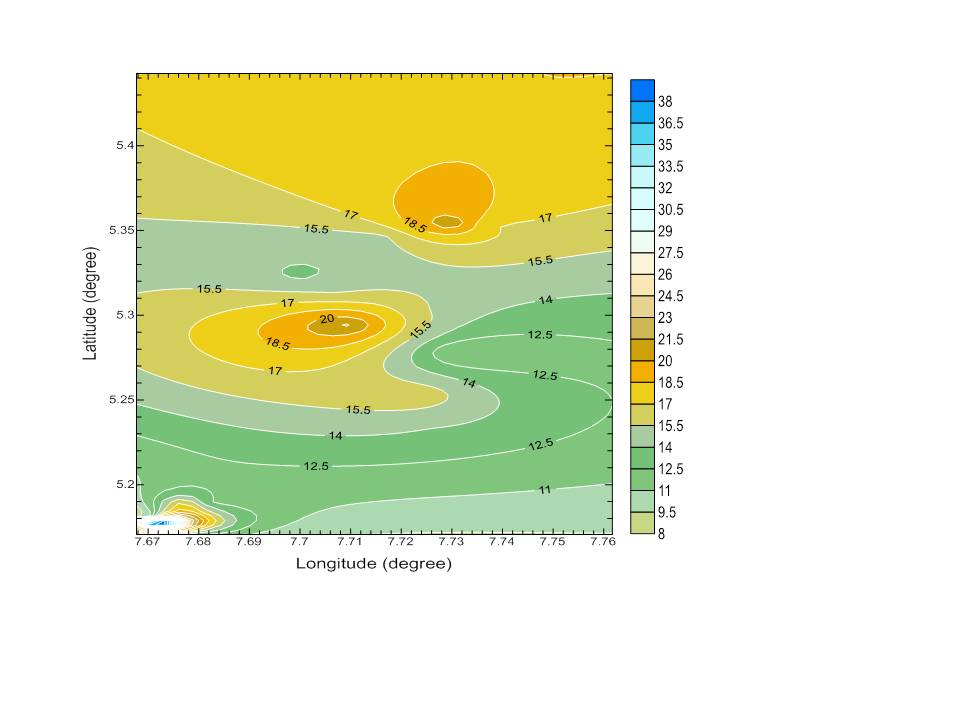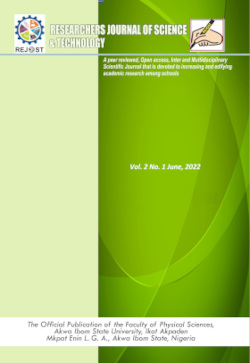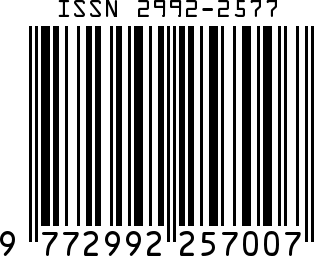Assessment of Radionuclides Uptake by Melon (Cucumeropsis mannii) Seeds from Selected Farms in Akwa Ibom State, Nigeria
Keywords:
Melon seeds, Activity Concentrations, Transfer Factor, Risk AssessmentsAbstract
Plants and animals (including humans) are vulnerable to ionizing radiation in many ways. One of these ways is through the food chain. This research aimed at assessing the radionuclide uptake by melon seeds from soil, and the effect of ionizing radiation in humans due to melon. The activity concentrations of natural radionuclides in soil and melon seed samples from twenty locations in the study area was conducted using a Gamma ray spectrometric system coupled with a NaI(Tl). The soil samples were quartered and put in the oven at 50 − 70°C for 1440 minutes in order to obtain a constant weight. The melon seeds were ground, dried and weighed. The samples were packaged into labeled nylon bags before being moved to the laboratory for analysis. The average activity concentrations of 40K, 238U and 232Th in soil samples were 397.56±7.61 Bq.kg-1, 17.37±0.29 Bq.kg-1 and 62.98±1.02 Bq.kg-1 respectively. The average activity concentrations of 40K, 238U and 232Th in melon samples were 521.49±8.47 Bq.kg-1, 15.50±1.67 Bq.kg-1 and 28.753±0.69 Bq.kg-1 respectively. The average values of absorbed dose rate, external and internal hazard indices, radium equivalent, annual effective dose rate and representative level index were 46.40 Bq.kg-1, 0.26 and 0.30 Bq.kg-1, 93.12 Bq.kg-1, 0.057 mSv.y-1 and 0.730 Bq.kg-1 respectively, for melon samples, while for soil samples, were 63.65 Bq.kg-1, 0.37 and 0.42 Bq.kg-1, 138.04 Bq.kg-1, 0.078 mSv.y-1 and 1.01 Bq.kg-1 respectively. The average values of the transfer factors of 40K, 238U and 232Th were 1.3693 (49%), 1.0041 (36%) and 0.4721 (15%) respectively. The regression analysis indicated nonlinearity between radionuclide concentrations in soil and that of melon seeds. Hence, the radionuclide concentrations in soil and melon seeds are not proportional.
References
Agbalagba, E. O. and Onoja, R. A. (2011). Evaluation of Natural Radioactivity in Soil, Sediment and Water samples of Niger Delta (Biseni) Flood Plain Lakes, Nigeria. Journal of Environmental Radioactivity. 102, 667–671.
Ahmed, N. K and El-Arabi, A. M. (2005). Natural Radioactivity in Farm Soil and Phosphate Fertilizer and Its Environmental Implications in Qena Governorate, Upper Egypt. Journal Environmental Radioactivity.84 (1):51-64.
Al-Jundi, J., Al-Bataina, B. A., Abu-Rukah, Y. and Shehadeh, H. M. (2003). Natural Radioactivity Concentrations in Soil samples along the Amman Aqaba Highway, Jordan. Radiation Measurements, 36, 555 – 560.
Amakom, C. M., Orji, C. E., Eke, B. C. Okoli, U. A. and Ndudi, C. S. (2017). The Influence of Selected Soil Physicochemical Properties on Radionuclide Transfer in Cassava Crops. International Journal of Plant and Soil Science, 14 (1): 1-7.
Avwiri, G. O. and Ononugbo, A. H. (2012). Natural Radioactivity Levels in Surface Soil of Oggba/Egbema/Ndoni Oil and Gas Fields. Energy Science and Technology, 4 (2): 89-94.
Awudu, A. R., Darko, E. O., Schandorf, C., Hayford, E. K., Abekoe, M. K. and Ofori- Danson, P. K. (2010). Determination of Activity Concentration Levels of 238U, 232Th and 40K in Drinking Water in a Gold Mine in Ghana. Operational Radiation Safety and Health Physics Journal, 99 (Suppl. 2): 149-153.
Dowdall, M., Gerland, S. and Lind, B. (2003). Gamma-emitting Natural and Anthropogenic Radionuclides in the Terrestrial Environment of Kongsfjord, Svalbard. The Science of the Total Environment, 305, 229-240.
Ejoh, E. F., Essiett, A. A.; Essien, I. E., Bede, M. C., Benjamin, E. U. and Atat, J. G. (2023). Estimation of Transfer Factor from Soil to Cassava in Ethiope East, Delta State, Nigeria. World Journal of Applied Science and Technology, 15(1) .85 – 92
Essen, I. M., Essiett, A. A., Essien, I. E., Ekanem, K. R., Bede, M. C. and Ehiwe, I. O., (2021). Soil-To-Fluted Pumpkin Transfer of Natural Radionuclides in Farm Lands in Akwa Ibom State, Nigeria. International Journal of Progressive Sciences and Technologies (IJPSAT) ISSN: 2509-0119. Vol. 28. Pp 546-554.
Essiet, A. A., Essen, I. M., Inyang, U. U., Inam, E., Essien I. E. and Isaac, E. O. (2022). Radioactivity Concentration and Radionuclide Transfer Factor Assessment in Afang Leaves (Gnetum africanum) Cultivated in Akwa Ibom State, Nigerian. International Journal of Research Publication and Reviews, Vol 3, no 6, pp 4290-4296.
Faanu, A., Adukpo, O. K., Okoto, R. J. S., Diabor, E., Darko, E. O., Emi-Reynolds, G., Awudu, A. R., Glover, E. T., Tandoh, J. B., Ahiamadjie, H., Otoo, F., Adu, S. and Kpordzro, R. (2011). Determination of Radionuclides in Underground Water Sources within the Environments of University of Cape Coast. Research Journal of Environmental and Earth Sciences, 3 (3): 269 -274.
Hutchison, S. G. and Hutchison, F, L., (1997). Radioactivity in everyday life: Journal of Chemical Education, 74, 501 – 505.
IAEA (2010) Handbook of Parameter Values for the Prediction of Radionuclide Transfer in Terrestrial and Fresh Water. Environments, Technical Report Series No. 472.
IAEA (International Atomic Energy Agency), (2000). Annual Report, Vienna.
Jibiri, N. N., Aluasa, S. K. and Farai, I. P. (2009). Radiological Hazard Indices Due to Activity Concentrations of Natural Radionuclides in Farm Soils from two High Background Radioactivity Areas in Nigeria. Int.J Low Radiation, 6 (2): 69 -76.
NRC (National Research Council), (2006). Lost Crops of Africa: Volume II: Vegetables.Washington DC, The National Academies Press.
Olaniyi, J. O. (2008). Growth and seed yield response of egusi melon to nitrogen and phosphorus fertilizers application,” American-Eurasian Journal of Sustainable Agriculture, vol. 2, no. 3, pp. 255–260.
Raad O. H. and Hayder H. H. (2011). Natural Occuring Radionuclides Materials. Radioisotopes- Applications in Physical Sciences. Available at htt://www.intechopen.com/books/radioisotopes-applications-in-physical-sciences/natural-occuring-radionuclide-materials. 26/6/2013.
Rand, M. E., Iman, T. A. and Waleed J. M. (2021). Transfer Factors from Soil to Plant of Natural Radionuclides at Abu-Ghraib City, Iraq Using Gamma Ray Spectroscopy. Journal of Physics: Conference Series, 1879 032071.
Santawamaitre, T., Malain, D., Al-Sulaiti, H. A., Matthews, M., Bradley, D. A. and Regan, P. H. (2010). Study of Natural Radioactivity in Riverbank Soils along the Chao Phraya River Basin in Thailand. Nuclear Instruments and Methods in Physics A., doi:10.1016/j.nima.2010.-10.057. (Article in Press).
Sarkar, S. C., Ali, I., Paul, D., Bhuiyan, M. R. and Islam, S. M. (2011). Measurement of Natural and Artificial Radioactivity in Soil at Some Selected Thanas Around the TRIGA Mark-II Research Reactor at AERE, Savar, Dhaka. Journal of Environmental Protection, 2, 1353 – 1359.
Schippers, R. R. (2000). Africa Indigenous Vegetables an Overview of the Cultivated Species, Chatham, UK, National Resources Institute/ACP-EU Technical Centre for Agriculture and Rural Co-operation.
Shukla, V. K., Lalit, B. Y. and Mishra, U. C. (1982). Natural Radioactivity Contentt of Indian Phosphate Rocks. Sci. Tot. Environ. 24: 65-72.
Turhan, S., Baykan, U. N. and Sen, K. (2008). Measurement of Natural Radioactivity in Building Materials Used in Ankara and Assessment of External Doses. Journal of Radiological Protection, 28, 83-91.
Tyovenda, A.A., Ocheje, J.A., Terver, S. and Uttah, E.U. (2022). Investigation of the Radiological Risk of Farmlands and the Transfer Factor from Soil to Crops in Jalingo and Wukari L.G.A of Taraba State, Nigeria. Journal of Environmental Protection, 13, 1-14.
UNSCEAR (1993). Sources and Effect of Ionizing Radiation. New York, United Nations.
UNSCEAR (2000). Source and Effects of Ionizing Radiation. Report to General Assembly, with Scientific Annexes. United Nations Scientific Committee on the Effects of Atomic Radiation, United Nations, New York, pp. 265 - 273.

Downloads
Published
How to Cite
Issue
Section
License
Copyright (c) 2023 Researchers Journal of Science and Technology

This work is licensed under a Creative Commons Attribution-NonCommercial-NoDerivatives 4.0 International License.




